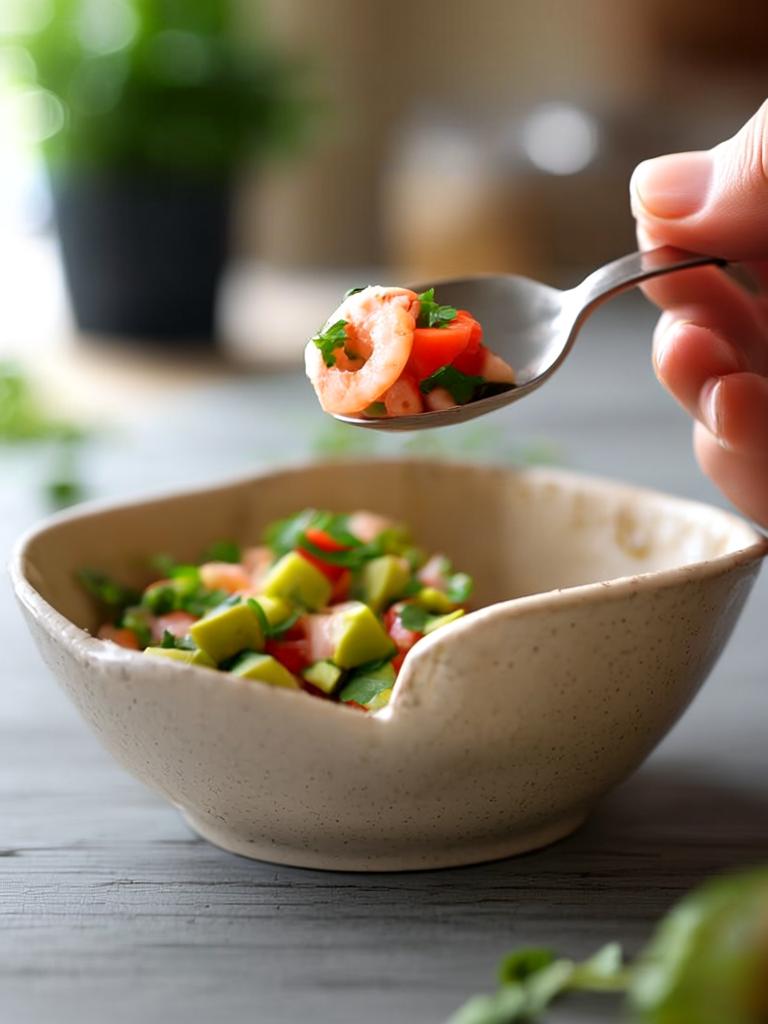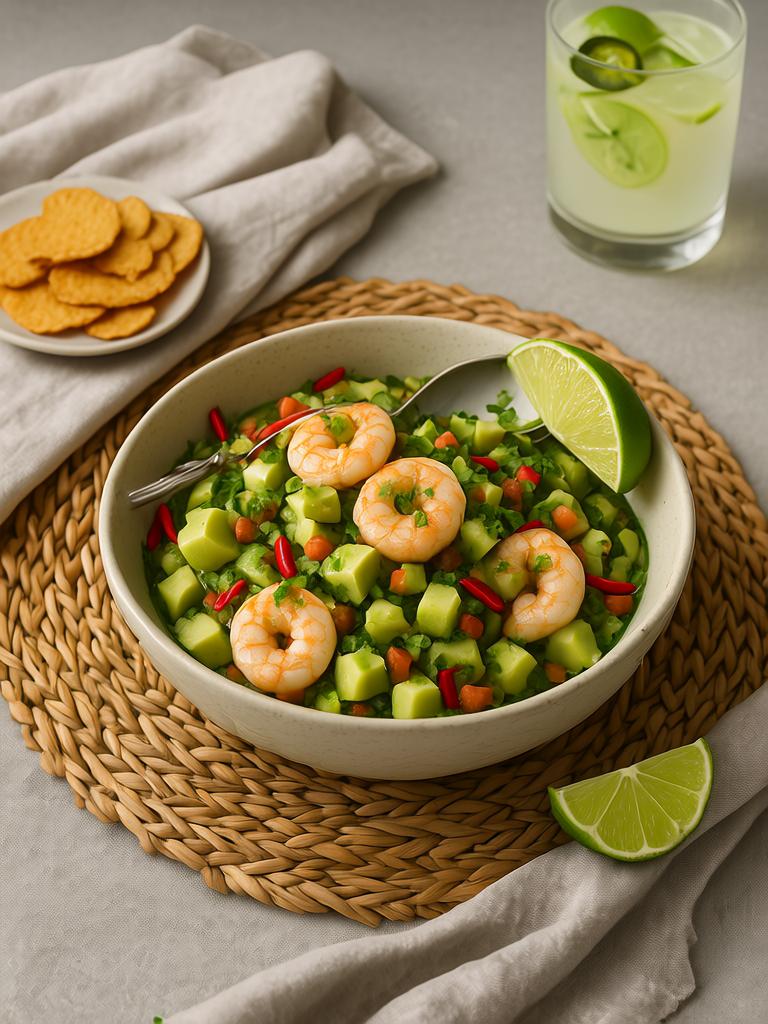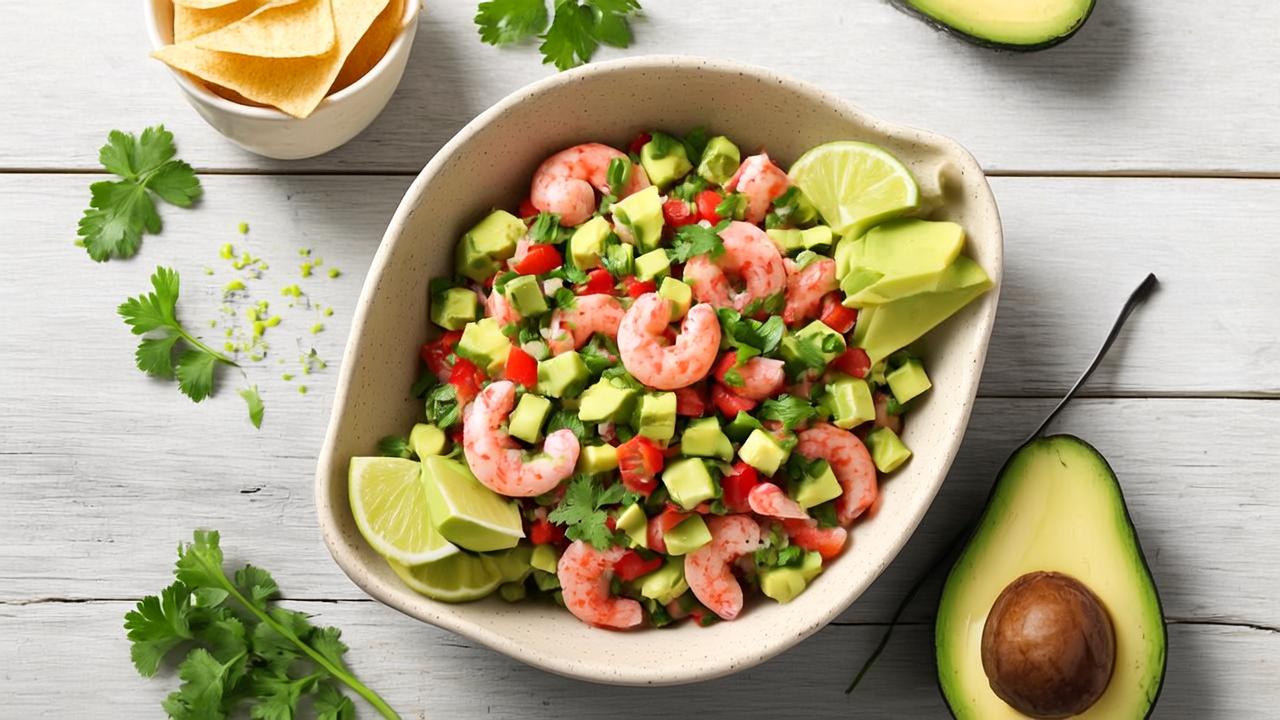The sharp tang of lime hits first. Then the creamy avocado kicks in like velvet on the tongue. And finally, that pop—tender shrimp, perfectly cured, dancing with cilantro. This isn’t just a pretty plate of ceviche. This is technique. This is balance. This is a dish with a soul that speaks in citrus and silence.
Ceviche, at its core, is deceptively simple. But when you’re working with raw ingredients—especially seafood—you’re not just tossing together a summer salad. You’re building chemistry. You’re conducting a cold marinade that needs precision, timing, and just the right amount of restraint.
Today, we’re diving deep into Shrimp and Avocado Ceviche with Lime and Cilantro—an old Latin American gem, made new with a studied hand.
Understanding Ceviche: Not Just “Raw Fish Salad”
Ceviche, or cebiche depending on where you’re standing, is a cornerstone dish throughout Latin America. Most historians trace its origin back to coastal Peru, with heavy Spanish and Moorish influence.
It’s not just a mix of seafood with citrus. It’s a cold-cooked dish. That means no stove, no sauté, but a chemical process where acid (usually lime or lemon juice) denatures the proteins in fish or shrimp. That’s what gives it a “cooked” texture—without ever turning on the flame.
But not all ceviche is equal. And shrimp ceviche? That’s a whole different game.
The Shrimp Matters: Sourcing and Prepping
First off, don’t play around with subpar shrimp. You’ll regret it halfway through your first bite.
Look for wild-caught, preferably Gulf or Pacific white shrimp. Fresh is best, frozen can work—just avoid pre-cooked. Pre-cooked shrimp in ceviche is a bit like putting cream in espresso. It mutes the whole point.
You’ll want to devein and clean thoroughly. If using raw, flash poach them in boiling water for 15–20 seconds max just to kill surface bacteria. No longer. Then shock ‘em in ice water. That’s it.
And here’s a trick many overlook: cut the shrimp after the lime bath begins. Why? It keeps the juices inside and avoids the stringy chew.

The Lime-Cilantro Equation: It’s Science (And Taste)
Lime juice isn’t just acid—it’s a flavor profile. Key limes offer a sharper, more floral edge. Persian limes (those big grocery store ones) are more mellow but still do the job.
For a brighter ceviche, mix both. Add a splash of orange juice for depth—yes, that’s legal.
Cilantro, though? That’s love or war. Some say it tastes like soap (blame genetics). But if you’re a fan, use it fresh and chopped right before tossing. Never use pre-cut or bruised cilantro. It turns metallic fast. And don’t be shy—you want at least ¼ cup chopped per pound of shrimp.
A little secret? Adding cilantro stems—finely minced—can boost the flavor without overpowering.
Avocado: Timing Is Everything
Here’s where most folks mess up. They throw in avocado too early. Big no-no. Avocado doesn’t like lime baths. It browns, gets mushy, and loses that clean, fatty contrast.
Instead, dice it right before serving. Gently fold it in with a soft spoon. Let it hug the shrimp without clinging.
Use Hass avocados, always. Their texture holds up and their flavor’s got that rich nutty tone that balances the acid beautifully.
Building The Perfect Ceviche: Step by Step
Here’s a breakdown pros actually use in kitchens—not the watered-down blog recipe version.
1. Cure the Shrimp
Place cleaned shrimp in a glass bowl. Pour over fresh-squeezed lime juice—enough to submerge. Cover. Let sit in the fridge for 15–20 minutes until opaque. Stir once halfway.
2. Drain Lightly, Then Toss
You don’t want soupy ceviche. Drain off excess lime juice but leave a little to carry the flavor. Add diced red onion, jalapeño, tomato, chopped cilantro, and a dash of salt.
3. Season. Wait. Taste.
Let it sit another 10 minutes in the fridge. Then taste for salt and acid. Adjust. You always need more salt than you think. But add in pinches. Not dumps.
4. Add Avocado & Serve Cold
Right before serving, fold in diced avocado. Spoon into a chilled bowl or serve in martini glasses if you’re feelin’ fancy.
Sprinkle extra cilantro or microgreens for garnish. A drop of olive oil? Sure. Not traditional—but divine.
Texture Matters More Than You Think
Real talk: the success of this dish lives and dies by mouthfeel.
If your shrimp’s rubbery, your limes are overpowering, or your avocado’s mush—start over. No one wants ceviche that eats like fishy baby food.
Cut shrimp into uniform pieces. Keep onion razor-thin. Use plum tomatoes (less juice), and dice avocado slightly larger than shrimp for contrast.
Play with crunch, too. Radish slices, diced cucumber, or even toasted corn nuts (cancha) bring in surprise and structure.
Nutrition Profile: Not Just Pretty Food
Let’s get nerdy for a sec. A well-balanced shrimp and avocado ceviche isn’t just tasty—it’s a nutrient bomb.
- Shrimp: High in protein (20g per 3oz), low in fat, with selenium, B12, and iodine.
- Avocado: Heart-healthy monounsaturated fats, potassium, fiber.
- Lime & Cilantro: High in antioxidants, vitamin C, and anti-inflammatory compounds.
This dish is naturally gluten-free, low-carb, and paleo-friendly. It’s practically the supermodel of appetizers. All flavor, no filler.
Misconceptions: Clearing Up the Citrus Confusion
There’s a myth out there that citrus kills bacteria like heat. It doesn’t. Citrus changes texture, not safety. That’s why using fresh, high-quality shrimp is non-negotiable.
Another misconception? More lime = better flavor. Nope. Over-acidify and you’re eating shrimp ceviche jelly. Always balance with a splash of neutral liquid—like orange or cucumber juice—to soften the edge.
And please, for the love of culinary decency, stop adding ketchup to ceviche. That’s not fusion. That’s confusion.
Regional Twists: Variations That Inspire
- Peruvian Ceviche: Uses firm white fish, leche de tigre (tiger’s milk), and sweet potato on the side.
- Mexican Style: Often includes tomato, cucumber, and sometimes clamato juice.
- Ecuadorian: Features a soupier, tangy ceviche often served with popcorn or plantain chips.
For our shrimp and avocado version, we’re somewhere in the Mexican ballpark—but you can borrow freely. Add mango for sweetness. Use serrano instead of jalapeño. Toss in scallions. Make it yours.
Pro Tips From the Line
- Always use non-reactive bowls (glass or stainless steel). Citrus can leech metal flavors outta aluminum.
- Chill every element before assembling. Warm tomatoes in cold ceviche? Weird.
- Taste the lime juice before using. Limes vary wildly in acidity batch to batch.
- Want it extra cold? Pop your serving bowls in the freezer 10 minutes before plating.

Pairing Suggestions: What to Serve With It
Ceviche sings best with contrast. Pair with:
- Tostadas or Salted Plantain Chips for crunch
- Dry Rosé or Citra-Hopped Pale Ale for brightness
- Cold cucumber gazpacho as a side
- Or just keep it simple: cold beer, sun, and a patio.
Trends & Innovations: Where Ceviche’s Heading
Ceviche bars are exploding in culinary scenes worldwide—from Lima to L.A. Chefs are experimenting with sustainable fish, unusual citrus (like yuzu or calamansi), and wild herbs like epazote or hoja santa.
Some are even using sous-vide cured seafood to control doneness better before citrus hits. Others introduce fermented elements—like pickled shallots or miso citrus—to deepen the umami.
One standout trend? Ceviche as a taco filling. It’s street meets sea. And it works.
Final Thoughts: Simplicity With Standards
Shrimp and Avocado Ceviche with Lime and Cilantro isn’t about razzle-dazzle. It’s about knowing your product. Respecting your acid. And never cutting corners, even when the dish seems effortless.
Treat each ingredient like it matters—because it does. Every chop, every squeeze, every fold shapes the final bite. Don’t rush it. Don’t guess. Taste, adjust, and serve it cold, bright, and proud.
Ceviche is a conversation between you and your ingredients. Make sure you’re listening.
Because when it’s right—oh man—it sings.
And there’s nothing like that first, clean, citrusy bite of shrimp, avocado, and lime.
FAQs
What type of shrimp is best for ceviche?
Wild-caught, fresh or high-quality frozen raw shrimp—never pre-cooked.
Can I use lemon instead of lime in shrimp ceviche?
Yes, but lime gives a sharper, more authentic flavor.
How long should I marinate the shrimp in lime juice?
About 15–20 minutes, just until the shrimp turns opaque.
When should I add the avocado to the ceviche?
Right before serving to keep it fresh and avoid mushiness.
Is shrimp ceviche safe to eat raw?
It’s “cold-cooked” in citrus, but use fresh, clean shrimp and handle it safely.
Can I make shrimp ceviche ahead of time?
Only a few hours ahead—add avocado last minute to keep texture.
What’s the best way to serve shrimp and avocado ceviche?
Cold, in chilled bowls or glasses, with tostadas or plantain chips.
Can I add other ingredients to the ceviche?
Yes, cucumber, mango, or radish add texture and flavor without overwhelming.
Is this dish healthy?
Absolutely—high in protein, healthy fats, and antioxidants.
Why does my ceviche taste too sour?
You likely over-limed it—balance with a splash of orange or neutral juice.
Can I store leftover shrimp ceviche?
It’s best fresh, but can be kept in the fridge for up to 24 hours max.
Is cilantro necessary in ceviche?
No, but it adds freshness; skip it if you dislike the flavor.

Mariana is a passionate home cook who creates delicious, easy-to-follow recipes for busy people. From energizing breakfasts to satisfying dinners and indulgent desserts, her dishes are designed to fuel both your body and hustle.
When she’s not in the kitchen, she’s exploring new flavors and dreaming up her next recipe to share with the Foodie Hustle community.

